
Tags
Share
Chatbots are one of the many communication tools organisations can use to interact with their customers, and there are numerous chatbot use cases to prove how successful they can be.
They’re computer programs that can interact with and respond to people, holding real-time conversations. Using chatbots alongside human agents can help to streamline workflows, increase productivity, and provide better customer service.
They can be deployed to perform various functions, including answering frequently asked questions, assisting customers in performing self-service tasks, and directing calls to the human agent best positioned to deal with their query.
Because of their versatility, chatbots are used across several industries. We’ll examine how they can positively affect your business and the best practices to ensure you get the most out of them.
But first, we’ll look at chatbot use cases and how organisations operating in different sectors can use them successfully.
7 customer service chatbot use cases
Chatbots are a great example of using AI in customer service. They assist in answering customer queries quickly, effectively, and inexpensively.
More than 30% of people view chatbots as a primary way of answering a question, with almost as many reporting they’d use chatbots to resolve a problem, get a detailed explanation, or receive general customer service.
Chatbots facilitate better self-service help for customers. They can answer frequently asked questions about multiple topics, from payment and postage queries to technical queries regarding specific products. Suppose customers of a particular product or service often contact customer services with questions about a specific pain point. In that case, a chatbot can be programmed to solve that problem quickly and easily.
That’s not the end of potential chatbot use cases for customer service. The chatbot could even link the customer to a tutorial or step-by-step video which shows them how to solve the problem. This reduces the instances where human agents have to spend time repeatedly talking customers through the same solution, allowing them to focus on other issues that require more attention.
1. Ecommerce chatbot use cases
Chatbots have a range of potential applications in the ecommerce sector. Thanks to their versatility, they can be deployed to various channels, meaning customers can access them at every stage of the customer journey.
A unified communications solution, like Dialpad, makes it easy to deploy chatbots across as many channels as you wish while keeping track of all your customer interactions in one place:
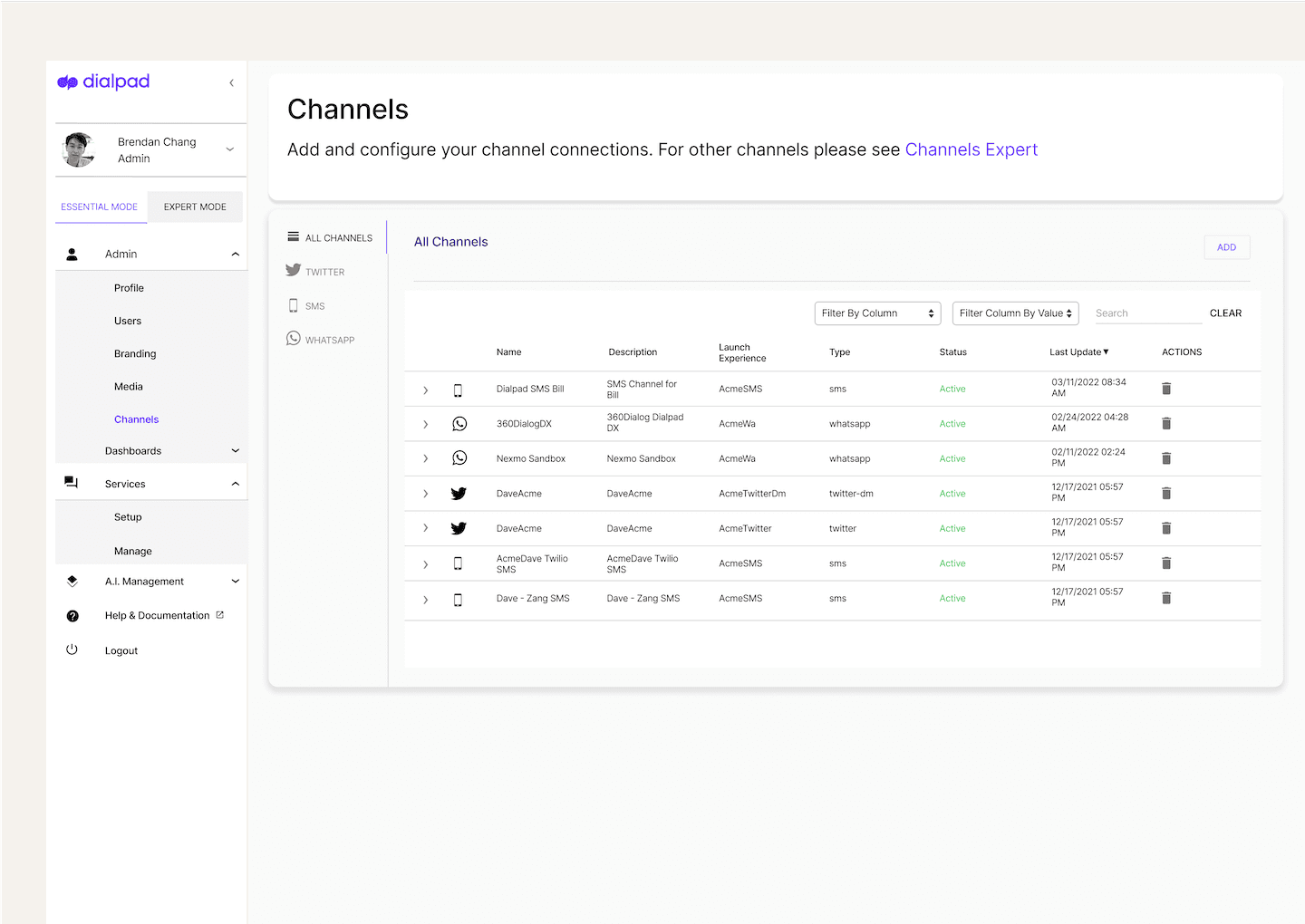
Customers with questions about account management, payment options, postage costs, returns processes, or anything else can turn to chatbots to quickly find the answers they’re looking for. Providing visitors with a quick way to obtain this information can help reduce bounce and cart abandonment rates.
Lead generation is more straightforward, as chatbots can capture customer details from website visitors. A chat window can pop up on an ecommerce website offering discount codes, special offers to users who sign up for a newsletter, or other similar initiatives.
Once obtained, these details can be fed into a company’s customer relationship management (CRM) software so that sales reps can follow up. Chatbots can even help to qualify and nurture leads, helping to turn them into prospects.
Multiple choice questions can be presented to website visitors to determine their needs and what kinds of products may benefit them. Personalised product offers can be presented using this information, and links to brochures or forms of content marketing, such as blog posts, can be shared.
The more information the chatbot can gather, the easier a human sales rep can nurture the lead and close the deal when they step in.
✨ UPLEVEL YOUR CUSTOMER EXPERIENCE
Grab the Contact Centre Playbook, which breaks down everything you need to know, from setup to improving customer satisfaction—with examples from real contact centre teams across different industries.
2. Chatbot use cases in retail
The retail industry can also benefit from chatbot usage. In fact, 40% of consumers have used one when engaging with a retailer, a much higher percentage than in other industries:
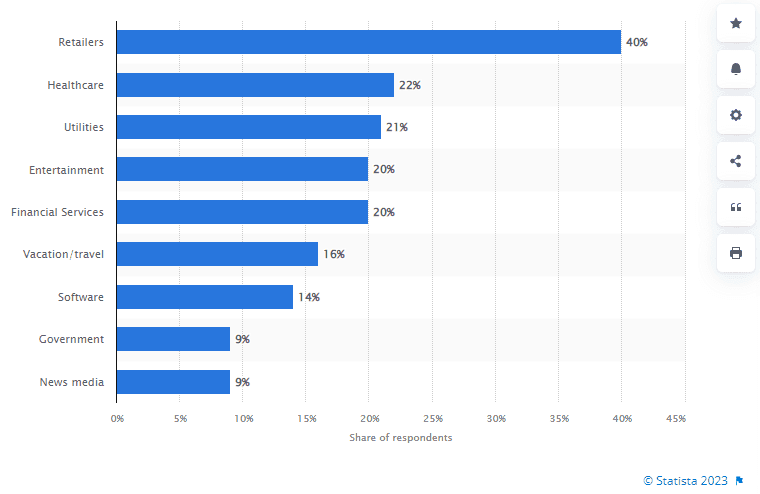
Marketing automation is just one of the ways that chatbots can assist retailers. They can be deployed across various channels, including on social networks and messaging apps. Here, they can ask customers questions to determine what kinds of products they may be interested in and make relevant recommendations.
Engaging with customers in spaces usually reserved for interactions with their friends and family can instantly make that brand feel much more special and relatable. It’s one way to achieve marketing personalisation, building a unique relationship between customer and brand that ultimately results in better customer engagement and loyalty.
3. Chatbot use cases in healthcare
Healthcare chatbot use cases can include providing medical information, scheduling appointments, collecting patient data, and even providing mental health assistance.
We’ve all had the experience of ringing the doctor’s surgery at opening time to try and schedule an appointment, only to end up 24th in a queue. In that situation, you could sit and listen to hold music for 45 minutes until a receptionist picks up, or you could take a different approach.
Chatbots can be used to schedule appointments in healthcare institutions. By accessing databases concerning available doctors, nurses, or other practitioners, as well as available appointment times, they can offer appointments to healthcare users and book them in. This automates the process and saves both patients and healthcare staff valuable time.
Chatbots can also be trained using data about the symptoms of illnesses and other diagnostic markers, enabling them to answer questions about patients’ health and advise possible courses of action.
4. HR chatbot use cases
When it comes to human resources, use cases for chatbots can be found in recruitment, onboarding, performance management, gauging employee satisfaction, and assisting with self-service queries around pay, holidays, and sickness.
HR chatbots can be used to whittle down the number of applicants for a job opening to a manageable amount.
Chatbots can also save recruiters a great deal of time that would otherwise be spent searching through applications by eliminating applications that do not meet a set of predetermined criteria, such as relevant qualifications or a set number of years of experience in the role and CVs.
Recruitment chatbots are incredibly easy to set up, provided you’re using the right software. Dialpad, for example, empowers users to build highly customisable chatbots for multiple channels without any prior coding knowledge:
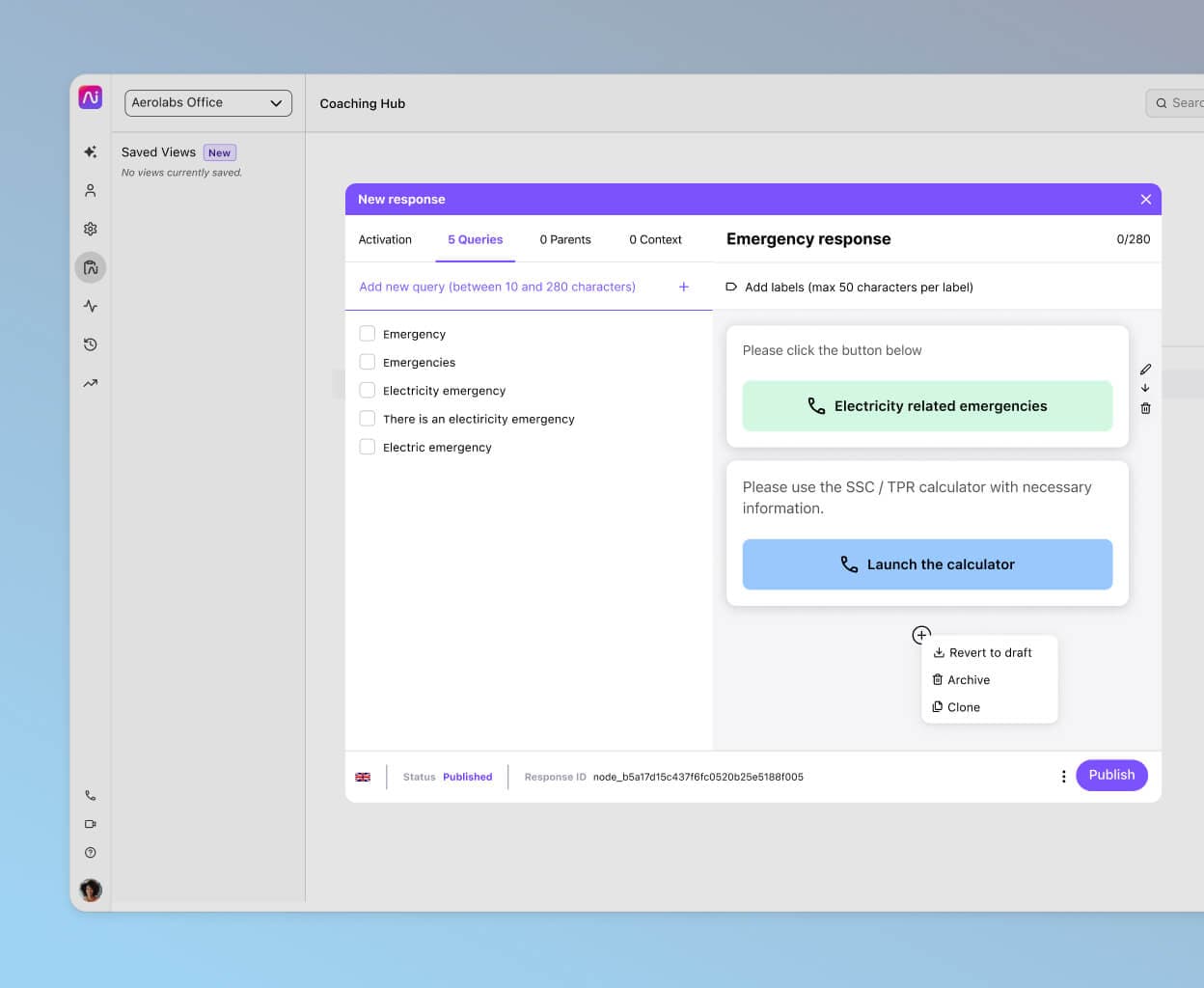
Chatbots can even carry out employee satisfaction surveys. Employees may feel more comfortable giving honest feedback and answering questions from a robot. Chatbots can be easily programmed to ask questions which can be answered on a scale, for example:
“On a scale from 1 to 5, how well do you feel the company respects your work/life balance”.
These kinds of questions can provide valuable insight into how engaged and satisfied employees feel and highlight potential areas for improvement in workplace culture.
5. Insurance chatbot use cases
Chatbots can be used in the insurance industry to provide account access and support for policyholders, receive claims, update policyholders on live claims, and generate quotes.
They can explain policies to potential customers and any tricky jargon they may be confused by. When it comes to actually buying a policy, the entire process can be automated. Quotes can be generated after asking pertinent questions of the customer, and details can be obtained to fill out the policy application.
The process of making a claim can also be automated using chatbots. Important information, necessary documents, and even supporting evidence can all be gathered by a chatbot, streamlining the claims-handling process for human agents.
This is especially useful in the event of a natural disaster such as an earthquake, flood, or another event that may lead to a large number of insurance claims being made at once.
Chatbots can proactively contact customers who are likely to have made a claim based on their location and can help relieve the strain from human agents who stand to become inundated with claims.
6. Chatbot use cases in telecoms
Telecom chatbot use cases can include assisting customers with self-service account management, capturing leads, and resolving customer pain points.
They can be used to investigate customer queries about their plans' technical aspects, such as signal loss issues. For example, if many customers in one area complained about a lack of reception, you could investigate if there’s an issue with a mast or other technology in that area.
Dialpad AI Contact Centre has features that make it easy to determine which queries are common and may point to a broader issue. Using "Custom Moments," you can track the instances where particular features are mentioned in customer service interactions. You can then use the built-in analytics to dig deeper into the transcripts and recordings of these calls to see exactly what customers are having issues with:
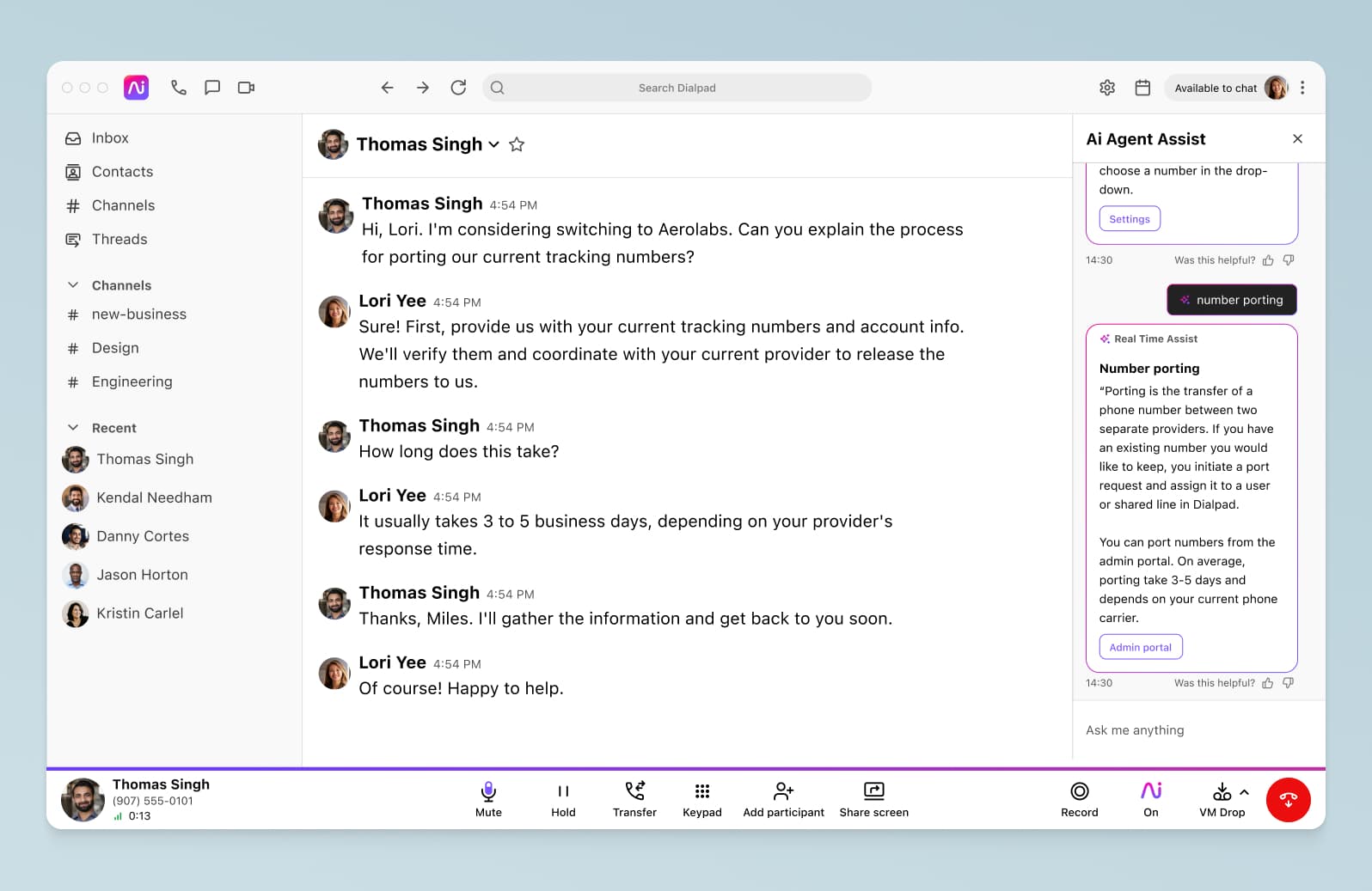
This can help you quickly identify problems affecting a large portion of your telecoms customers and act accordingly to rectify the issue.
7. Chatbot use cases in education
In the education sector, chatbots are used for fielding queries about courses, gathering student feedback, scheduling courses, simplifying the admissions process, and facilitating more personalised learning.
A chatbot can enrol learners in courses in the same way they can onboard employees. They can assess applications to ensure learners have the suitable grades and qualifications to enrol on the course and gather important information for student databases.
Chatbots can be on hand for online courses to answer queries and further explain materials, linking to outside resources when necessary. They can even be used to test students’ knowledge by administering mock exams and pop quizzes.
Using the information gathered from these exercises, chatbots can be used to determine how successfully course materials are being administered. If numerous learners have gaps in their knowledge in the same area, then it's possible that the course materials may need to be altered to compensate.
What can chatbots do for you?
Chatbots can have many positive impacts, from financial benefits to improving the digital customer experience:
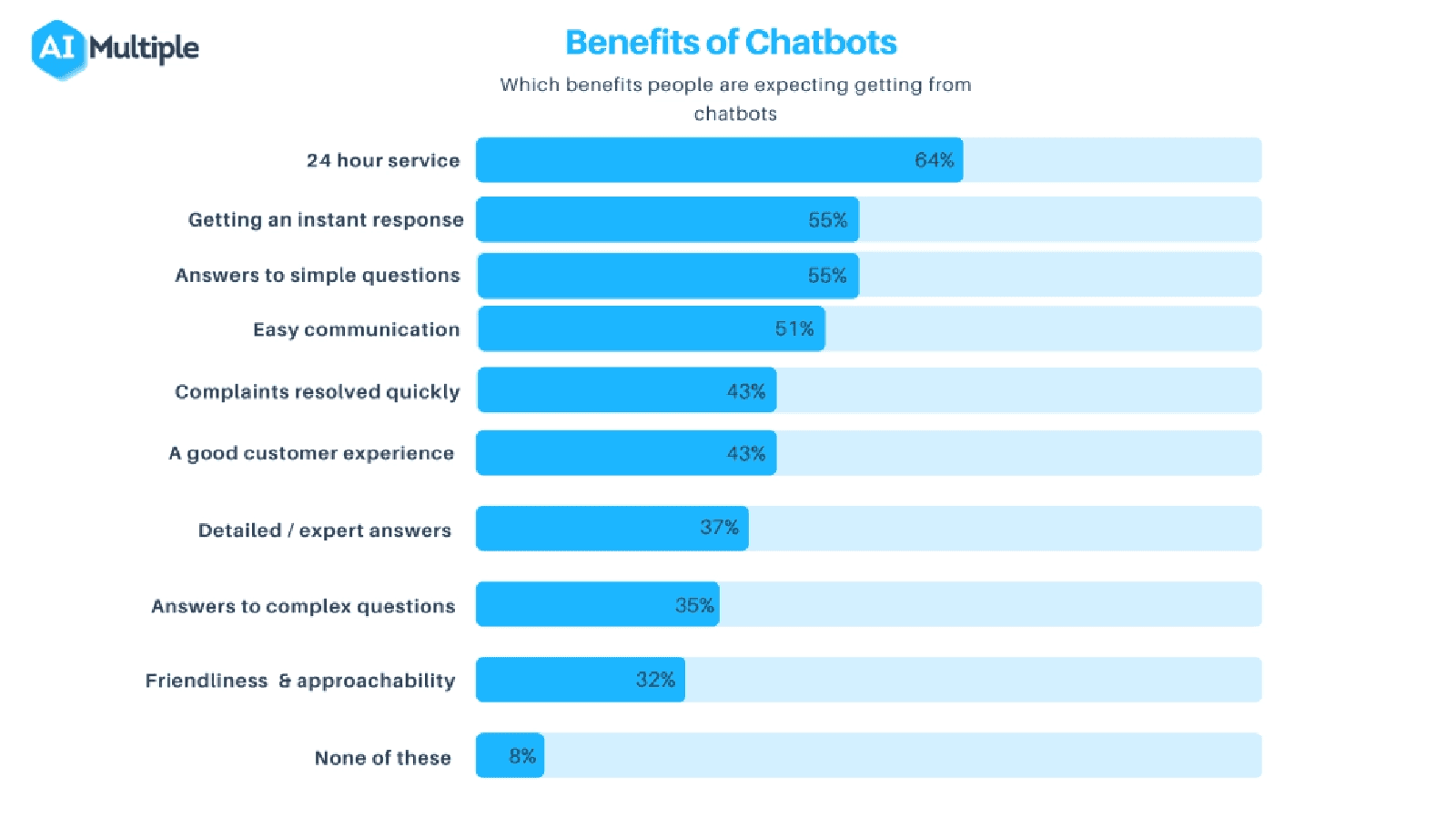
Generate more leads
Chatbots can be a helpful tool for generating leads in a sales environment by capturing the details of website visitors who wish to start a webchat.
Based on the information gathered, they can qualify these leads before passing them on to the sales team. Further questions can identify which stage of the customer journey the potential lead is at and which products or services they may be interested in.
Having chatbots gather this information, rather than a human agent, saves time for sales teams, meaning they can spend more time nurturing leads, pursuing prospects, and closing deals.
Increase sales
The customer experience can be improved in several ways using chatbots, helping to increase sales.
Chatbots deployed on ecommerce websites can send customers notifications about special offers or new products. Intelligent chatbots can even use the visitor's browsing history to recommend products they may be interested in based on what they’ve viewed in that session.
Personalising the shopping experience in this way can increase the number of conversions, as discounts or offers that may have otherwise been missed can be pointed out.
Chatbot usage during checkout can help alleviate pain points that may have otherwise led to cart abandonment. For example, a chatbot could answer questions about postage costs or discount codes.
Improve customer service
Chatbots are a fantastic tool for businesses wishing to achieve their customer service objectives, which can lead to an improvement in metrics like CSAT scores.
When contacting a company with a customer service issue, most customers want to receive a fast response and for their problem to be resolved quickly. Chatbots can help to achieve this. On top of that, chatbots are available 24/7 and are constantly ready to support customers, whether responding to simple queries using predetermined answers or fetching information from databases.
Even if a chatbot can’t immediately help with a request, the fact that they’re reducing the workload of customer service reps by handling the more straightforward tasks means that customers will have less time to wait if they need to be transferred to a human agent.
Omnichannel and multilingual support
Chatbots can be deployed across various channels, meaning customer service can be delivered at more points. If your business has global offices and a multilingual audience, you can also program your chatbot to provide multilingual support. This means customers worldwide can receive help when required without the company needing to employ service reps in different time zones.
Reduce costs
Implementing chatbots is a much more cost-effective solution than hiring more employees to support your sales and customer service teams.
Using chatbots to deal with simple, repetitive tasks, such as answering frequently asked questions or assisting with self-service, can free your agents up to handle more complex customer service requests.
Unlike human agents, chatbots can deal with thousands of queries at once, helping to quickly work through the backlog of customer service requests, increasing productivity and reducing costs.
9 best practices to make sure you use chatbots the right way
We’ve seen the various benefits that chatbots can bring to your organisation, but to really get the most out of them, there are several best practices that you should follow:
1. Use the right type of chatbot
If you want to use chatbots successfully, you must deploy the right kind. There are two distinct categories, each with advantages and varying suitability for different use cases:
Rule-based chatbot
Rule-based chatbots use predetermined responses to interact with users, following a conversation flow based on a decision tree.
They’re programmed to detect various keywords and phrases, and will often present various multiple-choice questions to the user to narrow down their query.
While effective at solving uncomplicated queries, rule-based chatbots can struggle when posed with more complex questions. If a user asks them a question that doesn’t contain any of their detectable keywords, they will fail to understand and won’t know how to respond.
Many organisations will use rule-based chatbots as a precursor to contact with a human agent. This allows them to gather contextual information, ensuring the user is in contact with the correct department and saving the human agent time.
AI chatbot (conversational AI)
AI chatbots use conversational AI to communicate with users more naturally. Using natural language processing (NLP), they can better understand more complex language and context clues and can respond in a more relevant way.
More adaptive than rule-based chatbots, AI chatbots can better replicate the experience of speaking with a human agent. This can help to provide a better customer service experience for users, as the chances of misunderstanding the query or returning irrelevant responses are reduced.
AI chatbots also have applications in sales scenarios, such as recommending products to website browsers based on their browsing history. It’s even possible to program AI chatbots with different personalities, allowing them to speak to target demographics and customer personas more naturally.
2. Know what makes a successful chatbot
Chatbots are often only as good as the person that programmed them. To get the most from your chatbots, you should ensure that they’re programmed to meet a few different criteria:
Concise: Chatbots which use simple language are more likely to be understood and can get to the point more quickly.
Turn-based: Chatbots need to wait for responses from the user rather than bombarding them with multiple messages at once.
Goal-oriented: Chatbots should be able to understand the user’s goal and direct them toward a solution with minimal effort.
Polite: It’s worth mentioning that your chatbots should be as polite and friendly as your human agents—they’re there to replicate the experience of speaking with one, after all.
3. Deploy chatbots on the right channels
Choosing the right channel to deploy your chatbots is essential for ensuring that as many people as possible use them. In many cases, meeting your users on the apps they already use is beneficial.
Chatbots can be deployed on messaging apps or social networks so that users can interact with them in an environment they’re familiar with without downloading a new app.
Chatbots can be easily deployed on your website. An interface that pops up in one corner of the screen can give users easy access to the chat function, without obstructing your website's content.
This allows users to interact with chatbots at every stage of their customer journey using the same interface, whether it’s making product suggestions, performing self-service account tasks, assisting with the checkout process, or facilitating easy returns and refunds.
4. Perfect the UI
The user interface (UI) of your chatbots will determine how successfully they’re used. Features such as buttons, quick replies, and multiple-choice selections can reduce the amount of text presented to users and speed up their interactions.
Seemingly small changes, such as allowing a date to be selected from an interactive calendar rather than being typed out manually, can greatly impact your user and how effective and intuitive they deem your chatbot to be.
5. Give your chatbot personality
Chatbots can be programmed with distinct personalities, which can go a long way towards making them more engaging for your users.
You should ensure that the tone of voice of your chatbot reflects that of your overall brand, creating a cohesive experience for customers.
In many cases, this will be informed by your key demographics. Meeting your users in a voice they can relate to will make them feel more comfortable and more likely to use the service again.
Giving your chatbots personality helps users to feel like they’re speaking to a real person, which makes them a more appealing prospect. 22% of people say the main reason they don’t use chatbots more frequently is because they seem “too robotic to engage with”.
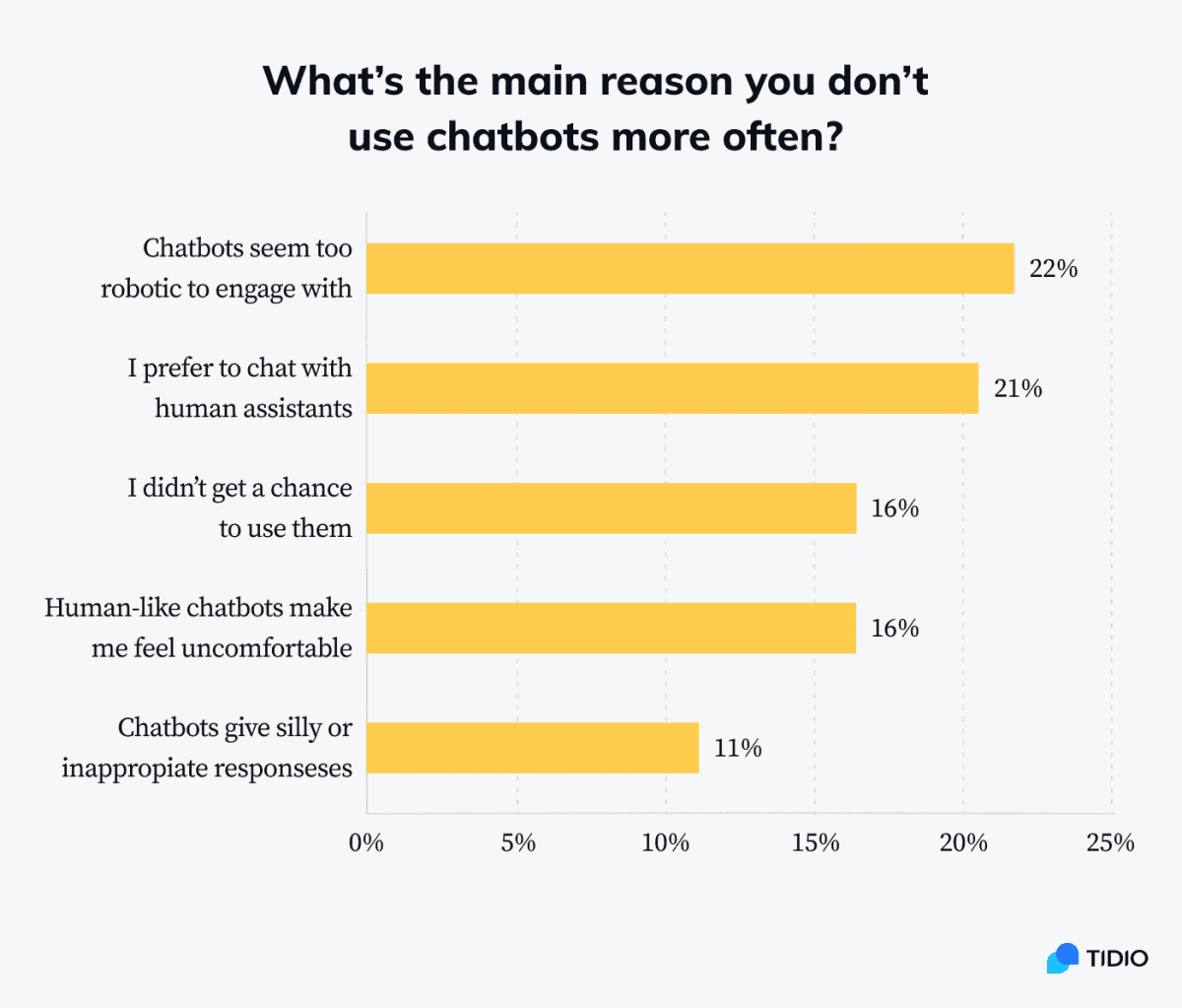
6. Measure your success
It’s essential to use key performance indicators (KPIs) to determine how successful your chatbots have been in their role. This will inform decisions on how they’re deployed in the future and can indicate any pain points that may need to be resolved.
For example, if you’re deploying a chatbot to assist with lead generation by directing traffic to your website from Facebook, you could measure the number of visitors to your landing pages and analyse where they were directed from.
If you’re deploying a customer service chatbot to speed up the time it takes for user queries to be resolved, you could look for reductions in the average handling times and customer wait times of your contact centre.
7. Gather feedback
Another great way to determine the success of your chatbots is to ask the people who’ve actually been using them.
You can implement a follow-up mechanism to trigger at the end of a conversation, presenting the user with a brief survey about their chatbot experience.
By including just a few quick questions and asking the user to rank the chatbot’s performance on a scale, you can gather helpful feedback about how well your chatbots are performing in their role and what could be done to improve them.
8. Automate strategically
Many of the queries handled by chatbots will be repetitive. AI chatbots can learn from each interaction and will use what they learn to resolve future queries more efficiently.
FAQ chatbots can be used to fetch responses from a list of predetermined answers in response to specific keywords. By using FAQ chatbots to answer the most common queries you receive, you can save time for your human agents while still providing adequate responses for your customers.
9. Be transparent about their limitations
Chatbots have come a long way in recent years, but there are some instances in which chatbot support simply cannot provide the same service as a human support agent.
60% of users who reported a negative experience with a chatbot said it was because they ultimately needed to speak to someone:
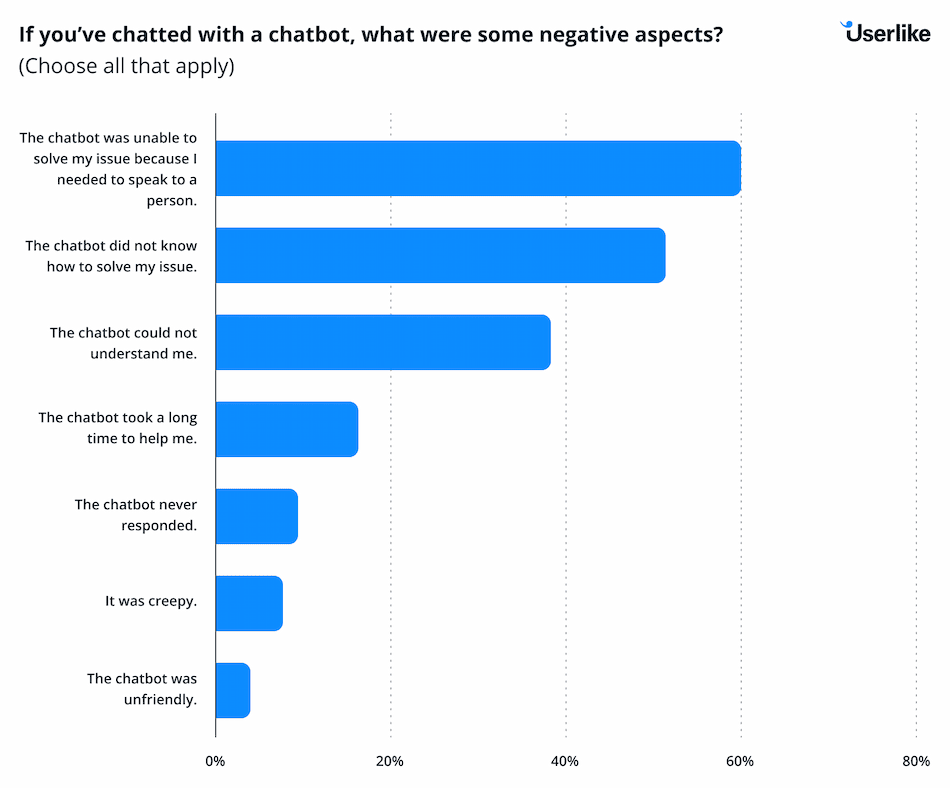
Some queries may be too complex for a chatbot to handle, even if it's armed with artificial intelligence. Having a process in place to transfer these users to a human agent in the relevant department will ensure that an efficient customer service experience is still provided.
In these instances, ensure the user knows this is what’s happening. A message can be displayed explaining that the chatbot can’t find the answer to the question right now, but they’re transferring them to somebody who will be able to help.
This ensures that the user doesn’t feel as if they’ve been abandoned and provides a continuous and cohesive customer experience.
Learn from these chatbot use cases before implementing this automation
Chatbots can help you automate your workflows, streamline your processes, reduce the workload of your human employees, and provide a cost-effective solution to a myriad of problems—regardless of what industry you’re operating in.
Whether it’s providing personalised service to your retail customers, solving the complaints and queries of telecoms users, or improving students' learning experience, implementing chatbots through a solution such as Dialpad can save you time and money.
Learn from the best chatbot use cases we’ve discussed here, and adapt what you discover to revolutionise processes for your own business.
Need a chatbot for your website?
Get a hands-on look at the smartest and most easily customisable chatbot around. Book a demo of Dialpad AI Contact Centre, or take a self-guided interactive tour of the app first!

